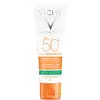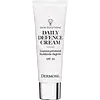What's inside
What's inside
 Key Ingredients
Key Ingredients

 Benefits
Benefits

 Concerns
Concerns

 Ingredients Side-by-side
Ingredients Side-by-side

Water
Skin ConditioningHomosalate
Skin ConditioningSilica
AbrasiveBifida Ferment Lysate
Skin ConditioningIsononyl Isononanoate
EmollientGlycerin
HumectantEthylhexyl Triazone
UV AbsorberButyl Methoxydibenzoylmethane
UV AbsorberBis-Ethylhexyloxyphenol Methoxyphenyl Triazine
Skin ConditioningPhenylbenzimidazole Sulfonic Acid
UV AbsorberOctocrylene
UV AbsorberCaprylyl Methicone
Skin ConditioningPentylene Glycol
Skin ConditioningAluminum Starch Octenylsuccinate
AbsorbentTriethanolamine
BufferingTitanium Dioxide
Cosmetic ColorantPotassium Cetyl Phosphate
EmulsifyingMethylene Bis-Benzotriazolyl Tetramethylbutylphenol
UV FilterAcrylates/C10-30 Alkyl Acrylate Crosspolymer
Emulsion StabilisingAluminum Hydroxide
EmollientAmmonium Acryloyldimethyltaurate/Vp Copolymer
Butylene Glycol
HumectantCaprylyl Glycol
EmollientDisodium EDTA
Glyceryl Stearate
EmollientKaolin
AbrasiveLauryl Methacrylate/Glycol Dimethacrylate Crosspolymer
Myristic Acid
CleansingPalmitic Acid
EmollientPEG-100 Stearate
Phenoxyethanol
PreservativePoloxamer 338
EmulsifyingPolyglyceryl-10 Laurate
Skin ConditioningSilica Silylate
EmollientSodium Benzoate
MaskingSodium Methyl Stearoyl Taurate
CleansingStearic Acid
CleansingStearyl Alcohol
EmollientT-Butyl Alcohol
PerfumingTerephthalylidene Dicamphor Sulfonic Acid
UV AbsorberTocopherol
AntioxidantParfum
MaskingWater, Homosalate, Silica, Bifida Ferment Lysate, Isononyl Isononanoate, Glycerin, Ethylhexyl Triazone, Butyl Methoxydibenzoylmethane, Bis-Ethylhexyloxyphenol Methoxyphenyl Triazine, Phenylbenzimidazole Sulfonic Acid, Octocrylene, Caprylyl Methicone, Pentylene Glycol, Aluminum Starch Octenylsuccinate, Triethanolamine, Titanium Dioxide, Potassium Cetyl Phosphate, Methylene Bis-Benzotriazolyl Tetramethylbutylphenol, Acrylates/C10-30 Alkyl Acrylate Crosspolymer, Aluminum Hydroxide, Ammonium Acryloyldimethyltaurate/Vp Copolymer, Butylene Glycol, Caprylyl Glycol, Disodium EDTA, Glyceryl Stearate, Kaolin, Lauryl Methacrylate/Glycol Dimethacrylate Crosspolymer, Myristic Acid, Palmitic Acid, PEG-100 Stearate, Phenoxyethanol, Poloxamer 338, Polyglyceryl-10 Laurate, Silica Silylate, Sodium Benzoate, Sodium Methyl Stearoyl Taurate, Stearic Acid, Stearyl Alcohol, T-Butyl Alcohol, Terephthalylidene Dicamphor Sulfonic Acid, Tocopherol, Parfum
Water
Skin ConditioningOctocrylene
UV AbsorberButyl Methoxydibenzoylmethane
UV AbsorberEthylhexyl Salicylate
UV AbsorberSilica
AbrasiveCoco-Caprylate
EmollientPotassium Cetyl Phosphate
EmulsifyingC12-15 Alkyl Benzoate
AntimicrobialButylene Glycol
HumectantCetearyl Alcohol
EmollientDimethicone
EmollientPhenylbenzimidazole Sulfonic Acid
UV AbsorberPolysilicone-15
UV FilterHydroxyethyl Acrylate/Sodium Acryloyldimethyl Taurate Copolymer
Emulsion StabilisingPhenoxyethanol
PreservativeLinoleic Acid
CleansingSodium Hydroxide
BufferingParfum
MaskingXanthan Gum
EmulsifyingDisodium EDTA
Ethylhexylglycerin
Skin ConditioningPolysorbate 60
EmulsifyingSorbitan Isostearate
EmulsifyingLinolenic Acid
CleansingWater, Octocrylene, Butyl Methoxydibenzoylmethane, Ethylhexyl Salicylate, Silica, Coco-Caprylate, Potassium Cetyl Phosphate, C12-15 Alkyl Benzoate, Butylene Glycol, Cetearyl Alcohol, Dimethicone, Phenylbenzimidazole Sulfonic Acid, Polysilicone-15, Hydroxyethyl Acrylate/Sodium Acryloyldimethyl Taurate Copolymer, Phenoxyethanol, Linoleic Acid, Sodium Hydroxide, Parfum, Xanthan Gum, Disodium EDTA, Ethylhexylglycerin, Polysorbate 60, Sorbitan Isostearate, Linolenic Acid
Ingredients Explained
These ingredients are found in both products.
Ingredients higher up in an ingredient list are typically present in a larger amount.
Also known as Avobenzone, this ingredient is a chemical sunscreen filter that provides protection in the UV-A range.
Avobenzone is globally approved and is the most commonly used UV-A filter in the world.
Studies have found that avobenzone becomes ineffective when exposed to UV light (it is not photostable; meaning that it breaks down in sunlight). Because of this, formulations that include avobenzone will usually contain stabilizers such as octocrylene.
However, some modern formulations (looking at you, EU!) are able to stabilize avobenzone by coating the molecules.
Avobenzone does not protect against the UV-B range, so it's important to check that the sunscreen you're using contains other UV filters that do!
The highest concentration of avobenzone permitted is 3% in the US, and 5% in the EU.
Learn more about Butyl MethoxydibenzoylmethaneButylene Glycol (or BG) is used within cosmetic products for a few different reasons:
Overall, Butylene Glycol is a safe and well-rounded ingredient that works well with other ingredients.
Though this ingredient works well with most skin types, some people with sensitive skin may experience a reaction such as allergic rashes, closed comedones, or itchiness.
Learn more about Butylene GlycolDisodium EDTA plays a role in making products more stable by aiding other preservatives.
It is a chelating agent, meaning it neutralizes metal ions that may be found in a product.
Disodium EDTA is a salt of edetic acid and is found to be safe in cosmetic ingredients.
Learn more about Disodium EDTAOctocrylene protects skin from sun damage. It absorbs UV-B with peak absorption of 304 nm. It is a common sunscreen ingredient and often paired with avobenzone, a UVA filter. This is because octocrylene stabilizes other sunscreen ingredients by protecting them from degradation when exposed to sunlight. Octocrylene is a photostable ingredient and loses about 10% of SPF in 95 minutes.
Octocrylene also acts as an emollient, meaning it helps skin retain moisture and softens skin. It is oil-soluble and hydrophobic, enhancing water-resistant properties in a product.
Those who are using ketoprofen, a topical anti-inflammatory drug, may experience an allergic reaction when using octocrylene. It is best to speak with a healthcare professional about using sunscreens with octocrylene.
The EU allows a maximum of these concentrations:
Learn more about OctocryleneParfum is a catch-all term for an ingredient or more that is used to give a scent to products.
Also called "fragrance", this ingredient can be a blend of hundreds of chemicals or plant oils. This means every product with "fragrance" or "parfum" in the ingredients list is a different mixture.
For instance, Habanolide is a proprietary trade name for a specific aroma chemical. When used as a fragrance ingredient in cosmetics, most aroma chemicals fall under the broad labeling category of “FRAGRANCE” or “PARFUM” according to EU and US regulations.
The term 'parfum' or 'fragrance' is not regulated in many countries. In many cases, it is up to the brand to define this term.
For instance, many brands choose to label themselves as "fragrance-free" because they are not using synthetic fragrances. However, their products may still contain ingredients such as essential oils that are considered a fragrance by INCI standards.
One example is Calendula flower extract. Calendula is an essential oil that still imparts a scent or 'fragrance'.
Depending on the blend, the ingredients in the mixture can cause allergies and sensitivities on the skin. Some ingredients that are known EU allergens include linalool and citronellol.
Parfum can also be used to mask or cover an unpleasant scent.
The bottom line is: not all fragrances/parfum/ingredients are created equally. If you are worried about fragrances, we recommend taking a closer look at an ingredient. And of course, we always recommend speaking with a professional.
Learn more about ParfumPhenoxyethanol is a preservative that has germicide, antimicrobial, and aromatic properties. Studies show that phenoxyethanol can prevent microbial growth. By itself, it has a scent that is similar to that of a rose.
It's often used in formulations along with Caprylyl Glycol to preserve the shelf life of products.
This ingredient is more commonly known as Ensulizole, a chemical sunscreen ingredient.
Ensulizole mainly protects UV-B (290-340 nm) but offers a little UV-A (320-400 nm) protection. It is often paired with less photo-stable sunscreen ingredients due to its photo-stability.
Due to it being water-soluble, Ensulizole helps give sunscreens a light and non-oily texture.
Ensulizole is approved worldwide:
Learn more about Phenylbenzimidazole Sulfonic AcidPotassium Cetyl Phosphate is the potassium salt of a mixture. This mixture consists of the esters from phosphoricacid and cetyl alcohol.
Potassium Cetyl Phosphate is an emulsifier and cleansing agent. Emulsifiers help stabilize a product. It does this by preventing certain ingredients from separating.
As a cleansing agent, Potassium Cetyl Phosphate helps gather oils, dirts, and pollutants from your skin. This makes it easier to rinse them away with water.
Learn more about Potassium Cetyl PhosphateSilica, also known as silicon dioxide, is a naturally occurring mineral. It is used as a fine, spherical, and porous powder in cosmetics.
Though it has exfoliant properties, the function of silica varies depending on the product.
The unique structure of silica enhances the spreadability and adds smoothness, making it a great texture enhancer.
It is also used as an active carrier, emulsifier, and mattifier due to its ability to absorb excess oil.
In some products, tiny microneedles called spicules are made from silica or hydrolyzed sponge. When you rub them in, they lightly polish away dead skin layers and enhance the penetration of active ingredients.
Learn more about SilicaWater. It's the most common cosmetic ingredient of all. You'll usually see it at the top of ingredient lists, meaning that it makes up the largest part of the product.
So why is it so popular? Water most often acts as a solvent - this means that it helps dissolve other ingredients into the formulation.
You'll also recognize water as that liquid we all need to stay alive. If you see this, drink a glass of water. Stay hydrated!
Learn more about Water